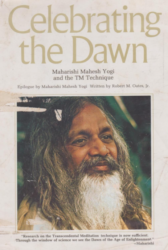The Inner Core of Peace

Mitakuye Oyasin: We are all related (American Indian Lakota tradition);
Vasudhaiva kutumbakam: The world is my family (Vedic tradition)
When I was a little girl, even from within the safe cocoon of my family and friends, it was deeply distressing to overhear the news about negative world events. Raised in a minister’s family where empathy was emphasized, I felt the pain of others intensely, but felt helpless to do anything about it. These days, especially, my heart goes out to children who hear the news. My heart goes out to everyone!
As I got older, I discovered—from my experience with TM and my studies—that we can contribute to alleviating the pain in the world. We can contribute to the creation of a peaceful world.
We often view the states of peace and war as if they were abstract entities, removed from our own individual lives. But peace and war are just the sum total of all the actions and interactions of the billions of individuals in the world. As long as we ourselves are not at peace, discord is inevitable. The first line of the UNESCO Constitution is: “That since wars begin in the minds of men, it is in the minds of men that the defences of peace must be constructed….” So the key to world peace is to create peace within the individual. Peaceful individuals make peaceful families, communities, countries, and world.
So how or where do we find lasting peace? Our tendency is to look outside ourselves for fulfillment, for happiness, for peace. But things that are temporary in nature—persons, things, accomplishments—only bring temporary fulfillment, temporary peace. The mind’s great thirst for a state of lasting happiness and peace can only be satisfied by something that is lasting in nature.
Spiritual traditions from around the world speak of the most fundamental state of human consciousness as containing the qualities of profound bliss and peace. In the Vedic tradition, this state is called Sat Chit Ananda: absolute bliss consciousness. The Christian tradition refers to the “kingdom of heaven,” and we will read Maharishi comments upon this universally cherished experience at the end of this post. When we experience bliss or deep joy by settling down to our truest nature in the silent depths of our being and grow daily in this quality, our restless search is satisfied, and we finally gain a lasting peace.
We might feel that focusing on our own inner bliss is selfish, but bear with me. We know that when we are happy and at peace, we get along with others easily, naturally, spontaneously—we transmit our joy to others! So bliss, the source of happiness, provides a solid, authentic foundation for peace within the individual and harmonious appreciation among individuals. And we experience bliss when we settle down, or transcend, to the quiet depths of our awareness.
But is it not just our harmonious interactions with others that contribute to peace. There is something even more subtle and powerful that results from transcending. When we experience that field of silence, pure consciousness, which is the home of all the laws of nature (read more), a nourishing influence is generated in the environment. This influence is even more powerful in large groups. This effect has been researched extensively with large groups of advanced TM meditators and is called the Superradiance or Maharishi Effect. (Research on world peace). When a group as small as the square root of one percent of a population practices TM and the advanced program, the TM-Sidhi program, the effect of harmony in the environment is powerful. This phenomenon has been described by many cultures throughout time. The ancient Vedic saying is: “In the vicinity of yoga [wholeness of consciousness], negative tendencies disappear.”
So even if we cannot get every individual in the world to meditate, we can have a powerfully harmonizing influence upon others through large groups of meditators, a body of peacemakers—a “corps of peace.” We will explore this in my next post.
For now, the important thing to remember is that peace and happiness arise from the deep silence which abides in each of us and which, through the practice of TM, we have the opportunity and means to experience daily. It is an experience that is basic to human nature. Writer Lucy Laud Montgomery spoke of it when she referred to her glimpses of this inner realm of beauty, seminal in her life:
“It has always seemed to me, ever since early childhood, that, amid all the commonplaces of life, I was very near to a kingdom of ideal beauty. Between it and me hung only a thin veil. I could never draw it quite aside, but sometimes a wind fluttered it and I caught a glimpse of the enchanting realm beyond—only a glimpse—but those glimpses have always made life worthwhile.” (The Alpine Path: The Story of My Career, pp 47-48).
Does the experience of this inner joy and peace mean we become complacent, no longer interested in creative expression and other people? Clearly, in the case of Lucy Maud Montgomery, a prolific writer of beautiful children’s classics, the reverse is true. Drawing from her own experiences, she writes in her novel, Emily of New Moon, of flashes of a “world of wonderful beauty,” and how this inner happiness blossoms outwardly: “She was so happy that her happiness seemed to irradiate the world with its own splendor….” (cited in Pearson, The Supreme Awakening).
We hear of others who have had similar glimpses which include love and a sense of relatedness to others. We recall the experience of Peace Pilgrim (post on Unity Consciousness)—her sudden experience of “timelessness, spacelessness and lightness,” in which she felt “more uplifted than she had ever been,” and most importantly to her, “included a oneness with that which permeates and binds all together and gives life to all….”
The American Indian Lakota tradition has a saying, Mitakuye Oyasin: We are all related. The Vedic phrase is Vasudhaiva kutumbakam: The world is my family. The sense of relatedness blossoms automatically as we experience our deepest inner nature, our peaceful core of joy. Within each of us is the region where we experience the Divine, permeated by love, which flows in appreciation for others, for life.
When I think of people who naturally embody this “world is my family” quality, the first person who comes to mind is my mother. At 85, she credits her 36 years of daily TM practice with revitalizing her inner joy and peace.
My mother relishes living in her multicultural apartment building and neighborhood with a very diverse population. Her background, however, was very homogenous, growing up on a small farm in the Midwest and attending a one room schoolhouse. Her ancestry is Swedish on both sides. She married my dad, also of Swedish ancestry, whom she first met in their Sunday school class. But she now adores the rich cultural diversity of where she lives (as did my father, before he passed away), and she cannot imagine living anywhere less diverse.
My mother has a genuine openness and interest in others, and she sees beyond appearance into the heart and core of others. This translates as respect. When people meet my mother, they sense her genuine interest in them. They feel her affection; they feel they matter; they feel her respect for them; and they feel her irrepressible joy. Consequently, my mom is adored by her neighbors.
So my mother is an example of an individual who is happy and radiates peacefulness throughout her community. When we are around such a peaceful individual, we feel nourished. We feel respected.
When you look into the etymology of the word “respect,” it is related to “seeing.” And “core” is related to the French word for heart, cœur. Perhaps “respect” involves seeing into the core—the heart—of the other. A person who receives such respect feels known, understood, appreciated. The person’s heart then opens.
An insight by a University of Maryland professor struck a note of truth within me. At a conference on conflict resolution, Dr. John Davies shared his discovery from his research: every culture has a need for respect from other cultures. This basic want, he found, was even more deep-seated than the need for material assistance. Respect, Dr. Davies argued, is fundamental to harmonious coexistence. (In my next post, we will look at research to which Dr. Davies contributed—on the collective practice of TM in trouble-spot areas of the world.)
Respect, friendliness, and care for others naturally radiate from a fully developed person, one who fathoms bliss deep within the most settled state of awareness. Experience of this inner core brings us in touch with springs of joy. And joy overflows with love. As Maharishi said about the most fully matured stage of human development, Unity Consciousness, “Everything becomes as dear as one’s Self.” (Read more)
In an interview with a Swiss journalist in 1971, Maharishi discussed how all spiritual leaders throughout time and space speak of our common core of spiritual experience, which he here refers to as the “kingdom of heaven” within. This is the source of the highest values in life, and when experienced and developed, naturally leads to compassionate behavior—“helping thy neighbor.” The following quotes in italics are from this recorded interview. (Christianity, Transcendental Meditation and Religion Explained by Maharishi, 23 November 1971, Mallorca, Spain)
The message of these masters is the message of Truth, Reality…. “Kingdom of heaven” [is] within you…. Every [individual]…should enjoy that heaven, that bliss consciousness, pure consciousness, which is deep within his mind, deep within his heart, deep within himself.
When we are fully established in bliss, the field of infinite peace, our restless search is satisfied. A deeply joyful individual is at peace and expresses peace. And this experience is not limited to a few, rare saints. (As my father once declared in a sermon, we all have the potential to become saints.) Because it is our deepest nature, it is accessible to all and is easy to experience. As Maharishi continued,
Within you is the kingdom of heaven and therefore something that is within you can easily be gained by you….
When we unfold this inner, universal field of life, we blossom in love and closeness to all beings. Maharishi said that this teaching—concerning the paramount importance of this innermost reality of life—is a universal message: [This] message of any religion is an immortal message to guide all mankind. It’s the same message. For example, the Lakota Sioux spiritual teacher Black Elk said: “Peace…comes within the souls of men when they realize their relationship, their oneness, with the Universe and all its powers, and when they realize that at the center of the Universe dwells Wakan-Tanka, [the sacred, the divine, the holy, The Great Spirit or Mystery] and that this center is really everywhere, it is within each of us.”
This sense of connectedness gradually grows as our stress dissolves and our hearts open. This is how TM helps us to experience the sacred source, “the center of the Universe.” Through silence and rest, TM simply and naturally clears away the obstacles, allowing us to experience our innate nature where we have kinship with all beings. Maharishi explained,
The same eternal message, broadcast from time to time by different teachers in different lands, becomes a cognizable reality, an experiential reality through Transcendental Meditation.… Every religion [or culture] teaches basically the same thing: purification of life, and communication with the higher state of evolution…. So it’s the eternal message.
This is what Transcendental Meditation meditators experience in their life. As they start to dive deep within, they begin to feel better, and the stresses are less and life becomes easier, and “help thy neighbor” becomes an instinct and an inspiration to everyone. One doesn’t have to know from the teaching that “help thy neighbor” is a good thing.… It’s not a matter of thinking and doing good, but one is structured in doing good.
On the basis of this shared experience of this field of unity, all aspects of life are nourished. Sharing this common core of inner fullness and joy, we become appreciative, respectful, caring neighbors—locally and globally. We relate to each other because we relate at the core of life, the inner sanctuary of stillness, where joy, peace, and love abound, and from where vitality streams forth in creative harmony with others.
On this basis we can envision a peaceful world. In my next blogpost, we will explore how this dynamic of transcending to create inner peace is enhanced through the collective practice of meditation, illustrating on a larger, more powerful scale the Vedic principle: “In the vicinity of yoga [wholeness of consciousness], negative tendencies disappear.”
References
Quotes by Peace Pilgrim and Lucy Maud Montgomery from Craig Pearson, The Supreme Awakening: Experiences of Enlightenment Throughout Time—And How You Can Cultivate Them.
Black Elk quote retrieved from google books preview: Joseph Epes Brown, Teaching Spirits: Understanding Native American Religious Traditions p 93
Further Reading
Peaceful Body, Peaceful Mind, Peaceful World by Charles Alexander, Ph.D.
About the Author
Cynthia Johnson is a teacher of the Transcendental Meditation program. She holds a Master of Theological Studies from Harvard Divinity School and is a mother, wife and writer. She is a contributor to the book A Symphony of Silence: An Enlightened Vision (1st and 2nd editions) by George Ellis.





